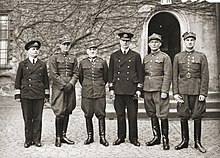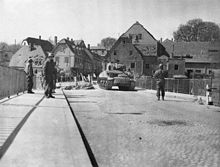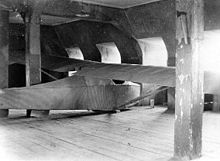Oflag IVc
Oflag IVc (for officers' camp IVc was) the official name for the camp for prisoners of war, Allied officers on Colditz Castle during World War II . After 1945 it became very well known , especially in Great Britain, through the processing of its many attempts to break out in books and films . In the English-language literature, it is also referred to as Oflag IV C or Oflag IV-C .
history
POW camp Oflag IVc
From 31 October 1939, was a POW camp called Oflag IVc as a special camp for officers set up (The name is derived from Of fiziers was he ). The camps in the imperial area were given the Roman number corresponding to the military district and a capital letter. The establishment of Colditz Castle was carried out in accordance with the international provisions of Article 6 of the Geneva Conventions in the version of October 18, 1907 and the Hague Land Warfare Regulations , which prescribe the handling of captured officers. At the same time, it was used as a special camp for celebrities such as Winston Churchill's nephew Giles Romilly and George Lascelles , a nephew of King George VI. intended. Traditional documents of the prisoners show that the camp name was partly unknown to them. Some reported in their memoirs that it was Stalag 4 (main camp 4).
Although thirty-one prisoners were able to escape successfully in three hundred attempts by the time the Nazi state collapsed in 1945, Colditz Castle was considered safe from escape. The Wehrmacht tried systematically to learn from the escape attempts by carefully examining the circumstances of each escape attempt and documenting it with photographs. Due to the above-mentioned international regulations, which were also carried out through repeated inspection visits by the International Committee of the Red Cross and the French Pétain government , the living conditions of the Allied officers at the castle under the command of Lieutenant Colonel Schmidt were more humane than in other Nazi camps . This fact of a model camp can also be seen in the pictures of the former inmate, the British professional officer and recreational painter William Faithful Anderson, painted between 1941 and 1945 . The headquarters was in the outer courtyard. The prisoners lived in the back courtyard in the former royal house. Outside, the flat terraces surrounding the prison buildings were guarded by armed guards and secured with barbed wire. From 1942, the castle was illuminated by spotlights at night, microphones were attached to the outer walls and a wooden catwalk surrounded the complex. On April 15, 1945, American soldiers liberated Colditz Castle and its occupants. Outbreaks and attempted breakouts were precisely documented by Security Officer Reinhold Eggers .
Commanders of Oflag IV
Surname Life dates period of service Colonel Schmidt * 1866; † 1946 or 1947 1939 - August 1941 Colonel Edgar Glaesche * 1889; † 1968 in Stuttgart-Degerloch August 1, 1941-13. February 1943 Colonel Gerhard Friedrich Prawitt * October 25, 1899 in Medenau / East Prussia ; † 1969 February 13, 1943-16. April 1945
1940
The first prisoners arrived in October 1940. There were 140 Polish officers who were considered dangerous to flee. Two weeks later, Donald Middleton , Keith Milne and Howard D. Wardle (a Canadian who joined the RAF shortly before the war) became the first British prisoners to arrive in Colditz. On November 7, 1940, six British RAF officers came: the "Laufen six". They were named after Laufen , the camp of their first attempt at escape. At Christmas 1940, 60 Polish , 12 Belgian , 50 French and 30 British officers and their orderlies were imprisoned in Colditz , a total of fewer than 200 prisoners.

1941
At the end of February, 200 French officers arrived in Colditz with their Général Le Bleu and Général Le Brigant. On July 24, 1941, another 68 Dutch officers, members of the Dutch East India Army, arrived who had refused to sign a declaration that they would not take part in any war against Germany. After that, a number of their uniforms were used for escape because they were similar to those of the German Wehrmacht, which used confiscated Dutch fabrics for part of their uniforms. Part of the French demanded that the French Jewish officers be separated from them. The camp commandant agreed and the Jews were placed in the attic. At the end of July 1941 there were more than 500 officers: over 250 French, 150 Poles, 50 British and from the Commonwealth, two Yugoslav and 68 Dutch. On April 9, Alain Le Ray was the first prisoner to escape from the camp. Alain Le Ray was later an active member of the French Resistance.
1942
On January 5, 1942, the British Lieutenant Airey Neave and a companion managed to flee through a hole in the cell ceiling via Leisnig by train to Leipzig in German uniforms.
1943
In May 1943, the Wehrmacht High Command decided that Colditz should only accommodate Americans and British. In June the Dutch were relocated, followed by the Poles, Belgians and French by July 12, 1943. At the end of July there were a few individual French officers, 228 British, as well as a few Canadians, Australians, New Zealanders, South Africans, Irish and one Indian.
1944
On August 23, 1944, the first Americans were interned in Colditz: the oldest American paratrooper of the war at 49 , Colonel Florimund Duke, as well as Captain Guy Nunn and Alfred Suarez. As a secret service employee, you jumped off with a parachute in Hungary and were supposed to prevent Hungary from cooperating with Germany. In the early winter of 1944 there were 254 inmates in the camp.
1945
On January 19, 1945, the French generals became Lieutenant-General Jean Adolphe Louis Robert Flavigny , Major-General Louis Léon Marie André Buisson , Major-General Arsène Marie Paul Vauthier , Brigadier-General Albert Joseph Daine and Brigadier-General René Jacques Mortemart de Boisse brought from Königstein Fortress to Colditz Castle. The transfer of these generals from Königstein to Colditz was intended to cover the murder of Major General Gustave Mesny , allegedly "shot while trying to escape". On February 5, the Polish General Tadeusz Komorowski , commander of the Polish Home Army (Armia Krajowa), arrived in Colditz with his company. Colonel Antoni Chruściel , commander of the Warsaw Uprising in 1944, was one of the high Polish officers imprisoned in the castle. In March 1945, 1200 French prisoners were brought to Colditz Castle, and 600 more were interned in the city of Colditz.
Attempted escape
The prisoners made a series of escape attempts, about which several books were published after the war. The most arduous attempt was a tunnel dug over nine months from the bell tower (Kellerhaus-Wendelstein) to the eastern area of the kennel in the winter of 1940. Thirty officers, including Airey Neave, dug the tunnel. But because they read the compass incorrectly, they erred in the direction and instead of going outside, they ended up in the wine cellar of the commanding officer, Colonel Prawitt. There they drank 137 bottles of wine, filled them with their urine and put these filled bottles back in the wine cellar. This story was confirmed by the widow Elisabeth Prawitt from Lüneburg in October 1974, but said that this did not happen to her husband, but to the predecessor. In 1945, the inmates planned to escape in a glider, the Colditz Glider, covered with white and blue checked bedding . It was built in a secret hiding place, camouflaged by a false wall in the attic, and was supposed to start from the roof of the castle chapel.
Afterlife
Colditz Society
In 1991 the Colditz Society was founded in London. 120 former prisoners from England, France and Poland meet twice a year in London and are in constant contact with the castle administration. In 2011 they found out about the sick willow in the castle courtyard, which had a symbolic meaning for the former prisoners, as it was already in the yard at the time of the POW camp. The members of the association donated a round bench around the newly planted linden tree . There is a regular publication of the association for members, in which their work is reported.
exhibition
In the Escape Museum numerous escapes and attempts to escape by officers of various nationalities are presented. In the past it was criticized that initially the internment of parts of the military leadership of Poland was not discussed.
media
The great international fame results in particular from the book The Colditz Story by the successfully fled British Pat Reid , in which he later processed his experiences, and from the 2005 film Colditz - Escape to Freedom by Stuart Orne . Through the depiction of escape attempts in several films and a television series, the castle became particularly well known in England. In addition to films from the 1950s and the TV series from the 1970s, the castle also served as a filming location for parts of an episode of the British TV series Top Gear .
In England there is a board game called Escape from Colditz , in which clever British officers lead the Teutonic jailer by the nose and then flee from Colditz by throwing the dice.
The ninth mission in the PC strategy game Commandos 2: Men of Courage takes the player to Colditz Castle, where various documents must be secured and the prisoners must be freed.
Filmography
- The indomitable - escape from Hitler's elite prison. Documentation, 45 min., Script and direction: Michael Wulfes , production: MDR , Arte , Ziegler Film GmbH, first broadcast: December 6, 2006, synopsis ( memento from September 30, 2007 in the Internet Archive ) of the MDR
- Colditz - Escape to Freedom . TV fiction in two parts: 240 min. And 185 min., Great Britain, director: Stuart Orme, production: Granada Television, first broadcast: March 27, 2005, Colditz in the Internet Movie Database (English)
- Escape from Colditz. Documentation, Great Britain, 2001 (interviews with former prisoners of war from Colditz Castle) Escape from Colditz in the Internet Movie Database (English)
- Colditz. TV feature film, 50 min., Great Britain, production: BBC , first broadcast: October 19, 1972, Colditz in the Internet Movie Database (English)
- In the shadow of the citadel (original title: The Colditz Story ) feature film, 94 min., 1955, director: Guy Hamilton, production: Ivan Foxwell Productions Ltd., The Colditz Story in the Internet Movie Database (English)
Individual evidence
- ↑ Scientific research on the Holocaust of the German Bundestag, printed matter 19/1980, p. 10.
- ^ A b Airey Neave: They have theire exits . Pen and Sword Military Classics, Barnsley, 2002, ISBN 1-84415-463-7 , page: 68ff.
- ↑ a b c d e f g P. R. Reid: Colditz. The full story . Pan Books, London, 2002, ISBN 978-0-330-50999-2 , page: 6ff.
- ^ A b c Regina Thiede, Renate Lippmann: Colditz Castle . Edition Leipzig, Leipzig 2007, ISBN 978-3-361-00620-1 , page: 14.
- ^ A b Carmen Lutz: POW camp Colditz Oflag IV C. 1939–1945 . Städtisches Museum, Colditz 2004, not specified, page: 4.
- ^ Roland Mischke: The bad boys of central Saxony. Colditz Castle with a legendary past, a dreary present and an uncertain future . Frankfurter Rundschau, May 4, 1996, page: 6.
- ↑ Erik Nebel: Escape attempts after the theater rehearsal . Spiegel online, February 26, 2007, ( online ), accessed July 4, 2011.
- ^ Website of the castle. (No longer available online.) Archived from the original on July 23, 2011 ; Retrieved July 3, 2011 . Info: The archive link was inserted automatically and has not yet been checked. Please check the original and archive link according to the instructions and then remove this notice.
- ↑ Information on the life data of the commanders, unless otherwise stated, according to www.colditzcastle.net ( Memento of the original from March 4, 2012 in the Internet Archive ) Info: The archive link was inserted automatically and has not yet been checked. Please check the original and archive link according to the instructions and then remove this notice. Retrieved January 8, 2012.
- ↑ a b c d e f Michael Booker: Collecting Colditz an its Secrects. A unique pictorial record of life behind the walls . Grub Street London, 2005, ISBN 1-904943-08-X , page: 30-37.
- ↑ no information: Died. Alain Le Ray. Spiegel online, No. 24, 2007, ( online ), accessed July 4, 2011.
- ↑ Birgit Zimmermann: Colditz glider for the hop off the roof. British officers once wanted to flee from German captivity with a wooden plane made from adventurous materials . Sächsische Zeitung, May 2, 2011, page: 6.
- ↑ ch: Colditz Society from London provides seating under the linden tree in the courtyard. Round thing. English finance new bank . Leipziger Volkszeitung, Muldentaler Kreiszeitung, June 8, 2011, page: 20.
- ↑ Markus Kroziska: Contribution to the discussion on the concept for the exhibition of the Foundation Flight, Expulsion, Reconciliation . University of Giessen, 2010, ( Link ), accessed on July 3, 2011.
- ↑ not specified: Program information: Top Gear feature - interview with Richard Hammond. , BBC website: ( Link ), accessed July 5, 2010.
- ↑ Jürgen Marks, Catherine Meyer, Alexander Wendt: Late revenge of the bad boys . Focus Magazin, Munich, April 15, 1995, ( online ), accessed July 4, 2011.
literature
- Regina Thiede, Renate Lippmann: Colditz Castle. Edition Leipzig, Leipzig 2007, ISBN 978-3-361-00620-1 .
- Albert Peter Bräuer: Colditz Castle. (Baudenkmale, booklet 56), Seemann, Leipzig 1983, ISBN 3-363-00487-7 .
- Reinhold Eggers: Colditz - the German story. 1961, several new editions, ISBN 1-84415-536-6 .
- Escape From Colditz. 16 first-hand accounts. Compiled by Reinhold Eggers. Edited by John Watton. London: Robert Hale 1973.
Web links
- Official website
- "Great Escapes" , 2006 exhibition at the Imperial War Museum in London
Coordinates: 51 ° 7 ′ 50.8 " N , 12 ° 48 ′ 26.9" E






